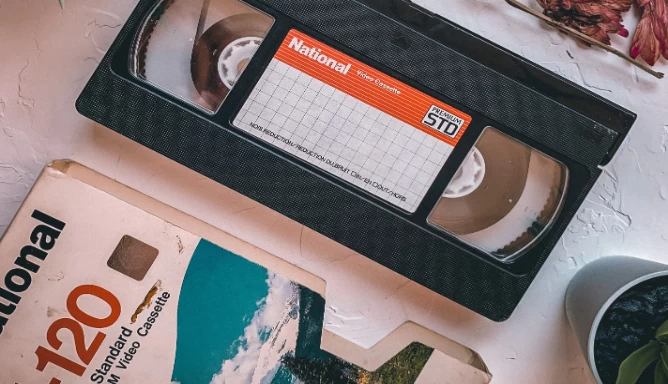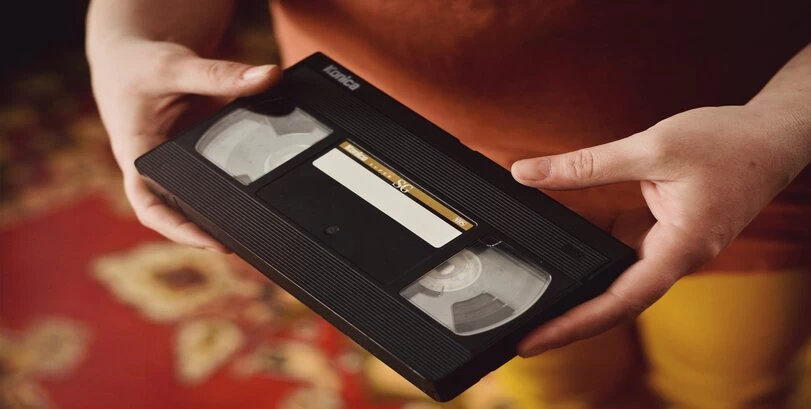A Timeline of Video Tapes to MP4 Formats
Explore the history of videotapes and how to convert them to MP4. From VHS to Betamax, learn the different formats and timelines for the evolution of video storage.
4 minutes to read

Converting Video tapes to MP4: The Evolution of Video Tapes
As technology continues to evolve, it's becoming increasingly important to keep up with the latest advancements to ensure that your memories are preserved in the best possible format. One such advancement is to convert video tapes to mp4 format. In this blog, we'll take a look at the timeline of video tapes to MP4 formats and explore why it's important to make the switch.
 Advertisement of a tape digitizing service with an image of two VHS tapes with Scrabble letters “ Movie” on it in a blue background.
Advertisement of a tape digitizing service with an image of two VHS tapes with Scrabble letters “ Movie” on it in a blue background.
Video tapes have been a popular format for home movies and recordings since the 1970s. The two most popular types of video tapes were VHS and Betamax. VHS was introduced by JVC in 1976 and quickly became the dominant format due to its longer recording time and lower cost. Betamax, introduced by Sony in 1975, had better picture quality but was more expensive and had a shorter recording time.
In the 1990s, a new format called Digital Video (DV) was introduced. This format used a digital signal instead of an analog signal, resulting in higher-quality recordings. DV tapes were smaller than VHS and Betamax tapes and were primarily used by professionals.
In the early 2000s, MiniDV tapes became popular with consumers. MiniDV tapes were even smaller than regular DV tapes and were used by consumers in camcorders. MiniDV tapes were digital and provided higher-quality recordings than VHS tapes.
As technology continued to evolve, digital formats became more popular. DVDs were introduced in 1995 and quickly became the preferred format for movies and TV shows. DVDs provided higher quality video and audio than VHS tapes and were more durable. However, DVDs were not suitable for recording and were not a good option for preserving home movies and recordings.
In 2003, the first consumer-level high-definition (HD) camcorders were introduced. These camcorders used HDV tapes, which were digital and provided high-quality recordings. HDV tapes were smaller than MiniDV tapes and were the first digital tapes to offer HD video.
 A person holding a VHS tape.
A person holding a VHS tape.
In the mid-2000s, digital storage devices became more popular. External hard drives, USB drives, and SD cards were used to store and transfer digital files. These devices provided a more convenient way to store and share videos than tapes.
In the late 2000s, video sharing websites like YouTube and Vimeo became popular. These websites allowed users to upload and share videos online. Videos could be viewed by anyone with an internet connection, making it easier to share home movies and recordings with friends and family.
In the 2010s, MP4 became the preferred format for videos. MP4 is a digital video format that provides high-quality video and audio in a small file size. MP4 files can be played on almost any device, making it easy to share videos with others. MP4 files are also compatible with most video editing software, making editing and customizing videos easy.
Today, converting video tapes to MP4 format is becoming increasingly important. Video tapes degrade over time and can become damaged or unusable. Converting video tapes to MP4 format ensures that your memories are preserved in a digital form that can be easily shared and edited. MP4 files can be stored on external hard drives or in the cloud, providing a more secure way to store and back up your videos.
In conclusion, the timeline of video tapes to MP4 formats has been a long and evolving one. From VHS to Betamax to MiniDV to HDV, technology has continually improved the quality and convenience of video recordings. Today, MP4 is the preferred format for videos, providing high-quality video and audio in a small file size that can be easily shared and edited. If you have old video tapes lying around, it's time to convert them to MP4 format to ensure that your memories are preserved for future generations.
